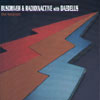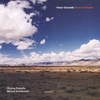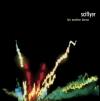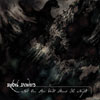 Asthe Weather, Los Angeles MCs Busdriver and Radioinactive dispense quickcut, weaving and rapid-fire rhymes with free-association styled contentranging from humorous to brilliant. Along with sample-basedcompositions and production from studio ace Daedelus, the trio havecollaborated on The Weather for sixty minutes of blisteringrhymes and hip hop meets clever musical arrangements, wierdness andsatire. "Pen's Oil" opens with a 18's inspired orchestration set tofunky drums and laid-back piano riffing that shifts to double time tokeep up with the speedy vocal dispatching. The playfully titled "CarlWeathers" consists of a full backing that includes machine beats,percussion and upright bass with a chorus that sings a line from atypical weather report while the duo convey simultaneous rhymes andbreak away for individual segments. A sampled audience clapping outsyncopated rhythms sets "Fine For A Robot" in motion for a soulfultrack when Busdriver, tongue in cheek, beautifully sings a loving odeto a machine. It then switches to drums and piano flourishes whenRadioinactive gets the sassy rhymes going for the robot girl. Daedelus'production on "Raffle Ticket Blues" employs dark, minor key jazz piano,bass and brushed drums segments with tinny machine beats forRadioinactive's wordplay in which the piece's sections are clearlymarked off based on the words per minute. The Weather's interestinglyrics and vocal talents of leaving no space unfilled are equallymatched by their ability to let lines breathe by leaving space betweenwords; all complemented nicely by Daedelus' rhythmic soundmanipulation.
Asthe Weather, Los Angeles MCs Busdriver and Radioinactive dispense quickcut, weaving and rapid-fire rhymes with free-association styled contentranging from humorous to brilliant. Along with sample-basedcompositions and production from studio ace Daedelus, the trio havecollaborated on The Weather for sixty minutes of blisteringrhymes and hip hop meets clever musical arrangements, wierdness andsatire. "Pen's Oil" opens with a 18's inspired orchestration set tofunky drums and laid-back piano riffing that shifts to double time tokeep up with the speedy vocal dispatching. The playfully titled "CarlWeathers" consists of a full backing that includes machine beats,percussion and upright bass with a chorus that sings a line from atypical weather report while the duo convey simultaneous rhymes andbreak away for individual segments. A sampled audience clapping outsyncopated rhythms sets "Fine For A Robot" in motion for a soulfultrack when Busdriver, tongue in cheek, beautifully sings a loving odeto a machine. It then switches to drums and piano flourishes whenRadioinactive gets the sassy rhymes going for the robot girl. Daedelus'production on "Raffle Ticket Blues" employs dark, minor key jazz piano,bass and brushed drums segments with tinny machine beats forRadioinactive's wordplay in which the piece's sections are clearlymarked off based on the words per minute. The Weather's interestinglyrics and vocal talents of leaving no space unfilled are equallymatched by their ability to let lines breathe by leaving space betweenwords; all complemented nicely by Daedelus' rhythmic soundmanipulation.  Asthe Weather, Los Angeles MCs Busdriver and Radioinactive dispense quickcut, weaving and rapid-fire rhymes with free-association styled contentranging from humorous to brilliant. Along with sample-basedcompositions and production from studio ace Daedelus, the trio havecollaborated on The Weather for sixty minutes of blisteringrhymes and hip hop meets clever musical arrangements, wierdness andsatire. "Pen's Oil" opens with a 18's inspired orchestration set tofunky drums and laid-back piano riffing that shifts to double time tokeep up with the speedy vocal dispatching. The playfully titled "CarlWeathers" consists of a full backing that includes machine beats,percussion and upright bass with a chorus that sings a line from atypical weather report while the duo convey simultaneous rhymes andbreak away for individual segments. A sampled audience clapping outsyncopated rhythms sets "Fine For A Robot" in motion for a soulfultrack when Busdriver, tongue in cheek, beautifully sings a loving odeto a machine. It then switches to drums and piano flourishes whenRadioinactive gets the sassy rhymes going for the robot girl. Daedelus'production on "Raffle Ticket Blues" employs dark, minor key jazz piano,bass and brushed drums segments with tinny machine beats forRadioinactive's wordplay in which the piece's sections are clearlymarked off based on the words per minute. The Weather's interestinglyrics and vocal talents of leaving no space unfilled are equallymatched by their ability to let lines breathe by leaving space betweenwords; all complemented nicely by Daedelus' rhythmic soundmanipulation.
Asthe Weather, Los Angeles MCs Busdriver and Radioinactive dispense quickcut, weaving and rapid-fire rhymes with free-association styled contentranging from humorous to brilliant. Along with sample-basedcompositions and production from studio ace Daedelus, the trio havecollaborated on The Weather for sixty minutes of blisteringrhymes and hip hop meets clever musical arrangements, wierdness andsatire. "Pen's Oil" opens with a 18's inspired orchestration set tofunky drums and laid-back piano riffing that shifts to double time tokeep up with the speedy vocal dispatching. The playfully titled "CarlWeathers" consists of a full backing that includes machine beats,percussion and upright bass with a chorus that sings a line from atypical weather report while the duo convey simultaneous rhymes andbreak away for individual segments. A sampled audience clapping outsyncopated rhythms sets "Fine For A Robot" in motion for a soulfultrack when Busdriver, tongue in cheek, beautifully sings a loving odeto a machine. It then switches to drums and piano flourishes whenRadioinactive gets the sassy rhymes going for the robot girl. Daedelus'production on "Raffle Ticket Blues" employs dark, minor key jazz piano,bass and brushed drums segments with tinny machine beats forRadioinactive's wordplay in which the piece's sections are clearlymarked off based on the words per minute. The Weather's interestinglyrics and vocal talents of leaving no space unfilled are equallymatched by their ability to let lines breathe by leaving space betweenwords; all complemented nicely by Daedelus' rhythmic soundmanipulation.  Journalists invent music sub-genres when they get tired of comparingmusical artists to another musical act. While Icelander OlafurJosephsson is once again showcasing his amazing playing, arrangement,and compositional talents for his second full-length disc as StafrænHákon, it's painfully difficult to escape the comparisons to Mogwai.(In addition, it's rather ironic than Josephsson now makes Glasgow hishome.) All of his music is instrumental once again on this, his firstrelease to be put out through somebody other than himself. For tensongs, the guitar and effects-driven melodies are a blissful wash ofdrifting audio landscapes. It's quite easy to get completely lost inthe music's beauty. Numerous songs like "Tætir rækju" pulse with asubtle beat and move within somewhat predictable, and enjoyable whilebeat-less tunes like "Grifflur" are chilling and turbulent like thebright moonlight reflecting off of cold, icy waters. With the additionof organic drum work and chiming sounds, however, songs like the closer"Safi" are unmistakably resemblant of Mogwai's tunes from their EP +release. There's nothing unpleasant about any of the songs, but what'slacking perhaps is an element of the unexpected, the unpredictabile, orchaos. There's so much that can be done with this music, but Josephssonchooses a route which leaves most of the music completely as is. Whileit may reduce the chances of being accused of being gimmicky, it doessound derivative. Skvettir Edik à Ref is a good second albumand will surely please a ton of fans of the more gentle side ofinstrumental guitar music. There is a load of potential for StefrænHákon to be amazing but it's just not quite at that level yet.
Journalists invent music sub-genres when they get tired of comparingmusical artists to another musical act. While Icelander OlafurJosephsson is once again showcasing his amazing playing, arrangement,and compositional talents for his second full-length disc as StafrænHákon, it's painfully difficult to escape the comparisons to Mogwai.(In addition, it's rather ironic than Josephsson now makes Glasgow hishome.) All of his music is instrumental once again on this, his firstrelease to be put out through somebody other than himself. For tensongs, the guitar and effects-driven melodies are a blissful wash ofdrifting audio landscapes. It's quite easy to get completely lost inthe music's beauty. Numerous songs like "Tætir rækju" pulse with asubtle beat and move within somewhat predictable, and enjoyable whilebeat-less tunes like "Grifflur" are chilling and turbulent like thebright moonlight reflecting off of cold, icy waters. With the additionof organic drum work and chiming sounds, however, songs like the closer"Safi" are unmistakably resemblant of Mogwai's tunes from their EP +release. There's nothing unpleasant about any of the songs, but what'slacking perhaps is an element of the unexpected, the unpredictabile, orchaos. There's so much that can be done with this music, but Josephssonchooses a route which leaves most of the music completely as is. Whileit may reduce the chances of being accused of being gimmicky, it doessound derivative. Skvettir Edik à Ref is a good second albumand will surely please a ton of fans of the more gentle side ofinstrumental guitar music. There is a load of potential for StefrænHákon to be amazing but it's just not quite at that level yet.  Combining cultural (i.e., traditional) instrumentation and phrasingwith more contemporary music always ends up producing something far toonew age and cheesey. It's a shame, especially when left as seperateentities, each can be quite gorgeous and ear-opening. Victor Chorobikand company have attempted to fuse various Tibetan sounds with those ofjazz and classical descent. The results are, at best, mixed andself-limiting. Exotic flutes are mixed with soprano and tenorsaxophones and each makes the other stand out like a sore thumb: thetwo simply don't fuse as well as the musicians would like to think.Lengthy tracks are accompanied by endlessly repeating drum patternswhile easy-going and laid back melodies shine over them, only themelodies aren't all that exciting or attention-grabbing. When thetraditional instrumentation and structures are left to themselves theresults are a little different. Chants, spoken-word passages, woodenflutes, and various guitars all mix to form something that borders onthe spiritual; they at least sound as if they are of a religiousbackground. Repeated listens will reveal that the native instrumentsare never truly left alone, however. There's always a keyboard of somekind attempting to add to the mystery and awe that native (or justplain alien) music, when completely naked, so often has the power ofevoking. The result is a pure stinking cheese that sucks the life outof the source material. This is nowhere more evident than on "Mantra ofGuru Rinpoche." A lone chant is performed only to be interrupted by acompletely pointless combination of shimmering keyboard sounds and lowbass throbbings. I've never been a big fan of these kinds of culturalcrossings precisely because they rob the uniqueness out of eachother.That's not to say that every single one of them are doomed to failure,but hearing the original stuff as documented in the field always endsup inspiring me more than what is meticulously calculated andconsidered within the studio. There is some beauty to be found here,but be prepared to be offended along the way. -
Combining cultural (i.e., traditional) instrumentation and phrasingwith more contemporary music always ends up producing something far toonew age and cheesey. It's a shame, especially when left as seperateentities, each can be quite gorgeous and ear-opening. Victor Chorobikand company have attempted to fuse various Tibetan sounds with those ofjazz and classical descent. The results are, at best, mixed andself-limiting. Exotic flutes are mixed with soprano and tenorsaxophones and each makes the other stand out like a sore thumb: thetwo simply don't fuse as well as the musicians would like to think.Lengthy tracks are accompanied by endlessly repeating drum patternswhile easy-going and laid back melodies shine over them, only themelodies aren't all that exciting or attention-grabbing. When thetraditional instrumentation and structures are left to themselves theresults are a little different. Chants, spoken-word passages, woodenflutes, and various guitars all mix to form something that borders onthe spiritual; they at least sound as if they are of a religiousbackground. Repeated listens will reveal that the native instrumentsare never truly left alone, however. There's always a keyboard of somekind attempting to add to the mystery and awe that native (or justplain alien) music, when completely naked, so often has the power ofevoking. The result is a pure stinking cheese that sucks the life outof the source material. This is nowhere more evident than on "Mantra ofGuru Rinpoche." A lone chant is performed only to be interrupted by acompletely pointless combination of shimmering keyboard sounds and lowbass throbbings. I've never been a big fan of these kinds of culturalcrossings precisely because they rob the uniqueness out of eachother.That's not to say that every single one of them are doomed to failure,but hearing the original stuff as documented in the field always endsup inspiring me more than what is meticulously calculated andconsidered within the studio. There is some beauty to be found here,but be prepared to be offended along the way. -  It used to be that when a band was called shoegazer music it was descriptive enough to illustrate exactly what someone would hear when they put the album on. These days, there are so many bands recording music that passes as shoegazer that it's almost evolved into another genre entirely, and none of it really resembles the original sound. Unfortunately, most of the bands in this genre possess little originality and more than their fair share of mediocrity. Sciflyer, hot off two self-released EPs, prove on their debut that there is still a chance for this kind of music while also displaying everything that's wrong with the psychedelic rock scene.
It used to be that when a band was called shoegazer music it was descriptive enough to illustrate exactly what someone would hear when they put the album on. These days, there are so many bands recording music that passes as shoegazer that it's almost evolved into another genre entirely, and none of it really resembles the original sound. Unfortunately, most of the bands in this genre possess little originality and more than their fair share of mediocrity. Sciflyer, hot off two self-released EPs, prove on their debut that there is still a chance for this kind of music while also displaying everything that's wrong with the psychedelic rock scene.
 In the office where I worked this summer, the main lobby featured anenormous piece by artist Frank Stella. The piece was large, probablytwenty feet tall, and consisted of a series of colored boxes, enclosedin a thick orange boarded and symmetrically mirrored on the oppositeside. These are the kind of works, abstract shapes and colors, thatmade Stella and his minimalist style known in the art world. Everymorning I would step off the elevators and be cast in the imaginaryshadow of this walled piece, unable to ignore it, and think to myself,"Is it me, or is this a total fraud?" I'm no art critic, but for me thepiece did nothing. It evoked no feelings and no deep thoughts, only theconfusion that a crayola palette and attention to straight lines couldto some extent, make one renowned. So excuse me for being somewhat warywhen Rebel Powers was described to me as minimalist. Rebel Powers is acollaboration between Acid Mothers Temple's Kawabata Makoto, CottonCasino, Koizumi Hajime and Telstar Ponies' David Keenan. Thesemusicians came together to perform two long instrumental tracks, withonly incidental overdubbing to create what they identify as minimalistexcursions. "We Are For the Dark" is the first volley, and quicklydispelled my initial fears. Guitars drone against each other as ghastlymoans supplied by a sarangi, a classical Indian bowed instrument.Percussion drips in and out of the shambling piece as it oozes forward.The darkness Rebel Powers aims to provide is very apparent, and "We AreFor the Dark" lays out in its patient tones a spooky, malevolentatmosphere that only builds in intensty and effectiveness as the trackcontinues. The instruments seem to grind against one another like therusty components of a machine lurching to life and slowly gaining backits momentum and force. Errant shards of noise shoot out into the stewbefore disappearing beneath it. In the tail end of its long duration,the improvisation reaches a more insistent peak before petering out ina collision of clangs and dwindling washes. The track is not spare orsparse, and never does it feel overly repetitive (though in essence ittreads the same core for twenty five minutes) or boring. It has a depthand body that draws you in and wraps you up in the imagery; it doesn'tleave you staring at it confounded. Unfortunately, the next track isnot nearly as successful. "Our God is A Mighty Fortress" mills aboutaimlessly over a repetitive pattern for far too long. While the firsttrack transported me to dark forests, rain soaked dirt roads andlurking unknowns in the brush just behind, the second track brings meright back to my office, staring up at the Stella and wondering tomyself what the big deal is. As the track progresses, it does improveslightly, with a more clean, more relaxed attitude than the first, butthe loss of energy and excitement that the first ten minutes or so is adevastating hit to the whole. Had the tracks been reversed in order, Imay have been more forgiving, but the ideas as presented took the windout of my enthusiasm. Such is the risk with improvised music. Sometimesideas don't pan out and paths taken more often lead to dead ends thanexplosions of brilliance, but when they do the trip is entirely worthit. As demonstrated by Rebel Powers, minimalism can mean more thaneconomy, and bleak can be busy, but that asceticism is a trap that isdifficult to escape.
In the office where I worked this summer, the main lobby featured anenormous piece by artist Frank Stella. The piece was large, probablytwenty feet tall, and consisted of a series of colored boxes, enclosedin a thick orange boarded and symmetrically mirrored on the oppositeside. These are the kind of works, abstract shapes and colors, thatmade Stella and his minimalist style known in the art world. Everymorning I would step off the elevators and be cast in the imaginaryshadow of this walled piece, unable to ignore it, and think to myself,"Is it me, or is this a total fraud?" I'm no art critic, but for me thepiece did nothing. It evoked no feelings and no deep thoughts, only theconfusion that a crayola palette and attention to straight lines couldto some extent, make one renowned. So excuse me for being somewhat warywhen Rebel Powers was described to me as minimalist. Rebel Powers is acollaboration between Acid Mothers Temple's Kawabata Makoto, CottonCasino, Koizumi Hajime and Telstar Ponies' David Keenan. Thesemusicians came together to perform two long instrumental tracks, withonly incidental overdubbing to create what they identify as minimalistexcursions. "We Are For the Dark" is the first volley, and quicklydispelled my initial fears. Guitars drone against each other as ghastlymoans supplied by a sarangi, a classical Indian bowed instrument.Percussion drips in and out of the shambling piece as it oozes forward.The darkness Rebel Powers aims to provide is very apparent, and "We AreFor the Dark" lays out in its patient tones a spooky, malevolentatmosphere that only builds in intensty and effectiveness as the trackcontinues. The instruments seem to grind against one another like therusty components of a machine lurching to life and slowly gaining backits momentum and force. Errant shards of noise shoot out into the stewbefore disappearing beneath it. In the tail end of its long duration,the improvisation reaches a more insistent peak before petering out ina collision of clangs and dwindling washes. The track is not spare orsparse, and never does it feel overly repetitive (though in essence ittreads the same core for twenty five minutes) or boring. It has a depthand body that draws you in and wraps you up in the imagery; it doesn'tleave you staring at it confounded. Unfortunately, the next track isnot nearly as successful. "Our God is A Mighty Fortress" mills aboutaimlessly over a repetitive pattern for far too long. While the firsttrack transported me to dark forests, rain soaked dirt roads andlurking unknowns in the brush just behind, the second track brings meright back to my office, staring up at the Stella and wondering tomyself what the big deal is. As the track progresses, it does improveslightly, with a more clean, more relaxed attitude than the first, butthe loss of energy and excitement that the first ten minutes or so is adevastating hit to the whole. Had the tracks been reversed in order, Imay have been more forgiving, but the ideas as presented took the windout of my enthusiasm. Such is the risk with improvised music. Sometimesideas don't pan out and paths taken more often lead to dead ends thanexplosions of brilliance, but when they do the trip is entirely worthit. As demonstrated by Rebel Powers, minimalism can mean more thaneconomy, and bleak can be busy, but that asceticism is a trap that isdifficult to escape.  This album is staggering in its creativity, even though it's probablythe most pop-focused of Rollerball's releases. They bring the funkinfluence, which has always been lurking, closer to the fore quitetastefully, with propulsive drums and full-bodied bass inspiringmovement, but the highlight of their music is definitely thesuper-catchy lyrics and melodies. Stabbing, anthemic horn leads andsmoky piano lines accompany their vaguely dadaist cabaret vocals,singing seemingly lighthearted verses about clarinet samples and ourforefathers wearing drag, but the sense of tension that their dramaticpresentation inspires is remarkable. Rollerball's little details oforganic experimentation and everything-including-the-kitchen-sinknoisemaking are still present in some form, but they're more tightlywoven into the songs themselves, such that the album is full ofinteresting sounds throughout, but free from gratuitously tacked onelements. Still, this is a far cry from the extended free-noise oftheir earlier works. Tracks like "66 Deadhead Spies" and "Starling"play up the loungey aspects—shared male/female vocals and slick pianoinstrumentation; while a steady bassline anchors "Mike's Hind," thesole instrumental piece, as various sound effects and improvisedphrases float through the mix. "Spine Delay" seems to be a shout out toall dudes in the audience with its deranged, at times hyper-falsetto,singing, until the horror-movie organ emerges and the band settles on amellow groove. The album ends with a suitably incomprehensible spokenword piece about nature. Rollerball are an entertaining and interestingband, and it's great to hear further development of their refreshinglyunique pop music.
This album is staggering in its creativity, even though it's probablythe most pop-focused of Rollerball's releases. They bring the funkinfluence, which has always been lurking, closer to the fore quitetastefully, with propulsive drums and full-bodied bass inspiringmovement, but the highlight of their music is definitely thesuper-catchy lyrics and melodies. Stabbing, anthemic horn leads andsmoky piano lines accompany their vaguely dadaist cabaret vocals,singing seemingly lighthearted verses about clarinet samples and ourforefathers wearing drag, but the sense of tension that their dramaticpresentation inspires is remarkable. Rollerball's little details oforganic experimentation and everything-including-the-kitchen-sinknoisemaking are still present in some form, but they're more tightlywoven into the songs themselves, such that the album is full ofinteresting sounds throughout, but free from gratuitously tacked onelements. Still, this is a far cry from the extended free-noise oftheir earlier works. Tracks like "66 Deadhead Spies" and "Starling"play up the loungey aspects—shared male/female vocals and slick pianoinstrumentation; while a steady bassline anchors "Mike's Hind," thesole instrumental piece, as various sound effects and improvisedphrases float through the mix. "Spine Delay" seems to be a shout out toall dudes in the audience with its deranged, at times hyper-falsetto,singing, until the horror-movie organ emerges and the band settles on amellow groove. The album ends with a suitably incomprehensible spokenword piece about nature. Rollerball are an entertaining and interestingband, and it's great to hear further development of their refreshinglyunique pop music. The second of the Anomalous co-releases is an oddly indefinable, "accidental" remix of Nurse With Wound's first album Chance Meeting on a Dissecting Table of a Sewing Machine and an Umbrella by Matt Waldron of irr.(app.)ext. Chance Meetingis a landmark record of deranged psychedelic proto-industrialexperimentation. Matt Waldron's irr.(app.)ext. has produced some of themost exciting audio surrealism to come along in recent years. However,this disc is not the meeting of these two great minds that one mightexpect. As the story goes, Waldron was making a tape-to-tape dupe ofthe original United Dairies cassette, when his dysfunctional taperecorder began to warp and mutate the source material, producing itsown interpolation of the Nurse classic. This kind of accidentallydeteriorating tape idea has recently been used to much more subtle andingenius effect on William Basinski's Disintegration Loops series.Although I can imagine that the warbles and mutations caused by thistape recorder mishap might have appealed to Matt Waldron and StevenStapleton, its pleasures are truly ephemeral. All the CD boils down tois an inferior, hiss-heavy transfer of the original album, with somerandom time-stretching, glitches and wobbles that do very little toincrease interest for the listener. Although I admire the love foraccident and synchronicity that led Stapleton and Waldron to releasethis material, I don't think that it will hold much interest for theaverage listener. This review certainly won't discourage those whoobsessively collect everything issued from the Nurse With Wound camp.But for those who are just a little more selective about this stuff, Ithink I can safely suggest that you steer clear of this unique butultimately inane piece of conceptual audio.
The second of the Anomalous co-releases is an oddly indefinable, "accidental" remix of Nurse With Wound's first album Chance Meeting on a Dissecting Table of a Sewing Machine and an Umbrella by Matt Waldron of irr.(app.)ext. Chance Meetingis a landmark record of deranged psychedelic proto-industrialexperimentation. Matt Waldron's irr.(app.)ext. has produced some of themost exciting audio surrealism to come along in recent years. However,this disc is not the meeting of these two great minds that one mightexpect. As the story goes, Waldron was making a tape-to-tape dupe ofthe original United Dairies cassette, when his dysfunctional taperecorder began to warp and mutate the source material, producing itsown interpolation of the Nurse classic. This kind of accidentallydeteriorating tape idea has recently been used to much more subtle andingenius effect on William Basinski's Disintegration Loops series.Although I can imagine that the warbles and mutations caused by thistape recorder mishap might have appealed to Matt Waldron and StevenStapleton, its pleasures are truly ephemeral. All the CD boils down tois an inferior, hiss-heavy transfer of the original album, with somerandom time-stretching, glitches and wobbles that do very little toincrease interest for the listener. Although I admire the love foraccident and synchronicity that led Stapleton and Waldron to releasethis material, I don't think that it will hold much interest for theaverage listener. This review certainly won't discourage those whoobsessively collect everything issued from the Nurse With Wound camp.But for those who are just a little more selective about this stuff, Ithink I can safely suggest that you steer clear of this unique butultimately inane piece of conceptual audio.  The English esoteric artists Current 93, Nurse With Wound and Coil —recently canonized in David Keenan's England's Hidden Reverse — areobviously intelligent, always creative, and often revolutionary. Ifanything bad could be said about these artists, it would be that theysuffer from a kind of record release diarrhea. Their absurdly prolificrelease schedules litter the world with pointless EPs, singles andlimited-edition releases that are immediately snatched up bycollectors, but often suffer from a dearth of worthwhile musicalcontent. Recent flagrant examples have been Current 93's The Great in the Small CD and the Maldoror is DeadEP. Both of these CDs contained no new musical content, and left mescratching my head wondering how I was hoodwinked into purchasing them.This new little artifact, one of a pair of discs released as apartnership between United Durtro and Anomalous, contains two lengthytracks of sound material from 1985's In Mentrual Night, recently given a remix treatment by Steven Stapleton. In Mentrual Nightwas one of David Tibet's final works from Current 93's "spooky loop"period, and also one of the best. The atmospheric mixture of chanting,operatic scales, chain-rattling and musique concrete' tape tricks was asuperior final chapter to Current 93's noisescape phase. Why revisitthis material almost 20 years later? These remixes were commissioned tobe used as opening music to Current 93's recent shows in San Fransisco.Because these pieces were to be used primarily for background music,Stapleton has decided to muddy the mix, making it impossible todistinguish the voice and noise elements, turning the music into murky,nebulous ambient soundscapes that fill the room with atmosphere, butdon't share the unfolding, jarring drama of the original music. Thesounds share the same kind of distant, dreamlike uneasiness of earlierCurrent 93 tracks like "The Dreammoves of the Sleeping King," withhalf-remembered audible fragments of sound that trigger strangefeelings of nostalgia and/or deja vu' in the listener. Both tracks arequite good, but whether or not they are worth the price of admissiondepends upon your level of Current 93 obsessiveness.
The English esoteric artists Current 93, Nurse With Wound and Coil —recently canonized in David Keenan's England's Hidden Reverse — areobviously intelligent, always creative, and often revolutionary. Ifanything bad could be said about these artists, it would be that theysuffer from a kind of record release diarrhea. Their absurdly prolificrelease schedules litter the world with pointless EPs, singles andlimited-edition releases that are immediately snatched up bycollectors, but often suffer from a dearth of worthwhile musicalcontent. Recent flagrant examples have been Current 93's The Great in the Small CD and the Maldoror is DeadEP. Both of these CDs contained no new musical content, and left mescratching my head wondering how I was hoodwinked into purchasing them.This new little artifact, one of a pair of discs released as apartnership between United Durtro and Anomalous, contains two lengthytracks of sound material from 1985's In Mentrual Night, recently given a remix treatment by Steven Stapleton. In Mentrual Nightwas one of David Tibet's final works from Current 93's "spooky loop"period, and also one of the best. The atmospheric mixture of chanting,operatic scales, chain-rattling and musique concrete' tape tricks was asuperior final chapter to Current 93's noisescape phase. Why revisitthis material almost 20 years later? These remixes were commissioned tobe used as opening music to Current 93's recent shows in San Fransisco.Because these pieces were to be used primarily for background music,Stapleton has decided to muddy the mix, making it impossible todistinguish the voice and noise elements, turning the music into murky,nebulous ambient soundscapes that fill the room with atmosphere, butdon't share the unfolding, jarring drama of the original music. Thesounds share the same kind of distant, dreamlike uneasiness of earlierCurrent 93 tracks like "The Dreammoves of the Sleeping King," withhalf-remembered audible fragments of sound that trigger strangefeelings of nostalgia and/or deja vu' in the listener. Both tracks arequite good, but whether or not they are worth the price of admissiondepends upon your level of Current 93 obsessiveness. Brian Foote has been operating the Outward Music Company out of Portland, Oregon for a few years. Their small number of releases have included some singles and full-length releases by Signaldrift, Solenoid, Pulse Programming, and Strategy. Nudge is the result of Foote's collaborations with members of those bands along with people from other Portland-based groups like Fontanelle, Jackie-O Motherfucker, and Nice Nice. While I have to admit that my impression of the outputs by the aforementioned artists and groups have always been rather lukewarm, the combination assembled here far supersedes any expectations.
Brian Foote has been operating the Outward Music Company out of Portland, Oregon for a few years. Their small number of releases have included some singles and full-length releases by Signaldrift, Solenoid, Pulse Programming, and Strategy. Nudge is the result of Foote's collaborations with members of those bands along with people from other Portland-based groups like Fontanelle, Jackie-O Motherfucker, and Nice Nice. While I have to admit that my impression of the outputs by the aforementioned artists and groups have always been rather lukewarm, the combination assembled here far supersedes any expectations.
 Some time ago, while sending out Rhys Chatham's "Die Donnergotter" overthe college airwaves, I got a call. I had expected another barelycontained "WHAT IS THIS?? IT'S...AWESOME!," which had become theregular response (maybe I played the song too much). Instead, my"Hello?" received the sleepyheaded reply, "Is this, uh, Trans Am?"Aside from the fact that a first-time Chatham listener will have beenexposed to legions of his influenced before hearing the man himself(most hear even Branca before his mentor), Chatham's work sounds a bitold-fashioned, ironically, because of what it has accomplished. Hisfusion of post-modern art music ("contemporary classical," "new-music,"whatever) with rock music sounds great, but it does not create worksthat enjoy unlimited movement between their poles of origin. Chathamwrites extensively about the critical climate of the '70s and '80s inthe 140-page book that accompanies An Angel Moves Too Fast to See,describing in detail the newfound flexibility and freedom along genrelines that composers enjoyed at the time. And while this all makessense, explaining how he came to write the music and perform this newmusic, it does not change the fact that Chatham's music will alwaysbelong to the classical tradition. This is not to say that the composerhad not gone to great lengths to separate his music from the universitysound lab, the ivory tower of academicism threatening art music throughthe late '60s. If anything, Chatham's music is not challenging enough.Still, despite his enlisting New York rock scene players (ThurstonMoore and Lee Renaldo among others) to perform his music and choosingto perform in many popular NY rock clubs, Chatham remains a "composer."The length and scope of his works contrast rock composition, especiallypunk rock composition; likewise, the spectacle and performer/audiencedynamic of a Chatham piece is necessarily different than that of aRamones show. Whether this would or would not be the case in a perfectworld cannot change Chatham's place as an "art-music composer" (who,yes, utilized rock instrumentation and technique). As such, itsimpossible to approach his work without any preconceptions about theperformative aspect of the music or without imagining its place withina lineage, however ill-conceived, of "important" 20th centurycompositions.
Some time ago, while sending out Rhys Chatham's "Die Donnergotter" overthe college airwaves, I got a call. I had expected another barelycontained "WHAT IS THIS?? IT'S...AWESOME!," which had become theregular response (maybe I played the song too much). Instead, my"Hello?" received the sleepyheaded reply, "Is this, uh, Trans Am?"Aside from the fact that a first-time Chatham listener will have beenexposed to legions of his influenced before hearing the man himself(most hear even Branca before his mentor), Chatham's work sounds a bitold-fashioned, ironically, because of what it has accomplished. Hisfusion of post-modern art music ("contemporary classical," "new-music,"whatever) with rock music sounds great, but it does not create worksthat enjoy unlimited movement between their poles of origin. Chathamwrites extensively about the critical climate of the '70s and '80s inthe 140-page book that accompanies An Angel Moves Too Fast to See,describing in detail the newfound flexibility and freedom along genrelines that composers enjoyed at the time. And while this all makessense, explaining how he came to write the music and perform this newmusic, it does not change the fact that Chatham's music will alwaysbelong to the classical tradition. This is not to say that the composerhad not gone to great lengths to separate his music from the universitysound lab, the ivory tower of academicism threatening art music throughthe late '60s. If anything, Chatham's music is not challenging enough.Still, despite his enlisting New York rock scene players (ThurstonMoore and Lee Renaldo among others) to perform his music and choosingto perform in many popular NY rock clubs, Chatham remains a "composer."The length and scope of his works contrast rock composition, especiallypunk rock composition; likewise, the spectacle and performer/audiencedynamic of a Chatham piece is necessarily different than that of aRamones show. Whether this would or would not be the case in a perfectworld cannot change Chatham's place as an "art-music composer" (who,yes, utilized rock instrumentation and technique). As such, itsimpossible to approach his work without any preconceptions about theperformative aspect of the music or without imagining its place withina lineage, however ill-conceived, of "important" 20th centurycompositions. The merits of this box have not gone unappreciated; the least of which,behind the sheer unavailability of many of these legendary Chathamcompositions and the beautiful package (decorated with Robert Longo'sphotography), is, surprisingly, the earliest of the compositionsincluded. "Two Gongs," an hour-long piece from 1971 that takes up theentire first disc of the box, is a gem of minimalist composition, andis reason enough to sing Chatham's praises. Performed by the composerand Yoshimasa Wada on two large Chinese gongs, the music swells andclangs, an ocean of squirming metal capable of simulating heroin stuporand root canal in equal measure. Should you remain convinced thatnothing will top Branca's guitar symphonies and wary that this box setmay prove you wrong, Table of the Elements has kindly released A Rhys Chatham Compendium,a single-disc sampler for the box that contains much of Chatham's bestwork, including "Die Donnergotter" and an excerpt from "Two Gongs."



